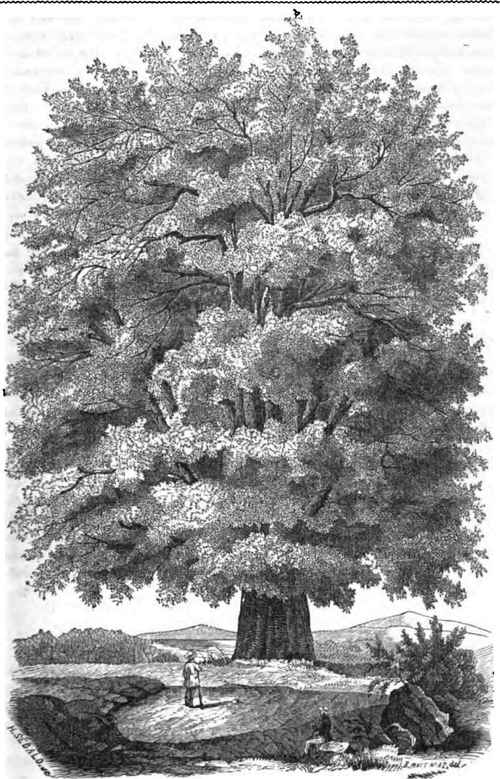Arboricultural Notices
Description
This section is from "The Horticulturist, And Journal Of Rural Art And Rural Taste", by P. Barry, A. J. Downing, J. Jay Smith, Peter B. Mead, F. W. Woodward, Henry T. Williams. Also available from Amazon: Horticulturist and Journal of Rural Art and Rural Taste.
Arboricultural Notices
In the hope that these notices may be the humble means of calling attention to many of our beautiful but neglected trees, I shall occasionally lay aside the rule I adopted at the commencement, - namely, to describe only those fine specimens growing in my immediate neighborhood. In the present instance, I have been so impressed with the injustice which our White Oak suffers from planters of ornamental trees, who very rarely indeed include it in their lists of " desirables" which they occasionally hand to their nurserymen, that I have taken for the subject of this sketch one in the grounds of Springbrook, near Holmesburg, Pa.; the Country Seat of Caleb Cope, Esq., which contains one of the handsomest specimens I have seen. It is not in its height (seventy-two feet), that it excels, for I have seen taller; nor in its circumference at four, feet from the ground (twelve feet) for there are occasionally some of greater dimensions met with; but as a vigorous, healthy, symmetrical, and withal a very large tree, it has few superiors. It has a very broad-base (see sketch), measuring near the ground line thirty feet; which adds materially to its grandeur and majesty. Its healthy vigor is no doubt owing in great part, to its favorable situation.
Located in the hollow formed by two gentle slopes, and below the level of a near turnpike road, the washings after heavy rains assist in affording nourishment just suited to it. The White Oak is getting so scarce in its native localities, that our posterity will speak of it as we do of the Mastodon, and other famed lords of the animal kingdom which once existed on this curious world, unless our planters pay more attention to it. Long ago Michaud wrote of it - "I must be allowed to hazard a conjecture on the consequences of the neglect of all means of preserving this tree in the United States; consequences which neither the Federal government nor the States, take any measures to prevent. From the increase of population and from the impoverishment of the soil, produced by a gradual change in the climate, the White Oak will - probably in less than fifty years - be most rare in the Middle States, where it is now most abundant, and in Tennessee, Kentucky, Genesee, and further North, where it is the least multiplied, it will be the most common, and will replace the species which now compose the forest, but which the soil will then be too feeble to maintain." When by the apathy and neglect of our planters, the White Oak shall have been lost to us, our descendants will thank the "Horticulturist" for preserving to them at least a sketch of this beautiful and noble tree.
Springbrook is comparatively a new place, having been made what it is quite recently, and by the present public spirited proprietor. Little more than seven years ago, when the writer first visited the grounds, the White Pines and Red Maples lining the carriage road, could be nearly measured by the hand; most of these are now thirty feet high, and three feet in circumference, showing what, by careful planting and subsequent attention, a few short years may accomplish. There is here also a fine specimen of the Acacia julibrusin, now in full blossom, about twenty feet high, and its trunk about thirty inches in circumference. Some portions of this tree always suffer in most winters, but notwithstanding, it always manages to increase each season "in grace and beauty.' Though when leafless, it is a very unpicturesque tree, there are few more pleasing when clothed with foliage. Near this an English bird Cherry (Cerasus padus) exists, a favorite small tree of mine. Its fragrant flowers in long racemes, appear a month earlier than our own pretty Wild Cherry (C. serotina), and serve to prolong a very interesting season. Those who admire dense headed, compact growing trees, will be pleased with a specimen of the English Maple (Acer campestre), a very fine specimen.
Its gooseberry-like leaves, and corky bark, give it a peculiar appearance; and near it is a Turkey Oak, about twenty-five feet high, and clothed with branches to the ground. Amongst the old trees that have long lived here, is a remarkably handsome specimen of the European Linden (Tilia Europea), about seventy or eighty feet high, with a pretty conical outline, the lower branches sweeping the ground for a wide distance around. Those who have ever seen this very pretty tree, or enjoyed but a short period its pleasant shade, will not readily join in the annual newspaper cry of "cut away the Lindens." A young but very vigorous specimen of the weeping variety of the American White Linden, (Tilia Michauxi, Nuttal), admonishes us that this beautiful tree is not near enough known or appreciated.

WHITE OAK.
Amongst the younger trees, of which it is the pride of the proprietor to have a specimen of each that can be obtained, I noticed as having stood the winter well and making vigorous growth, Pinus ponderosa about four feet high; P. pumilio, three feet; P. Mamiltoni, two feet; P. excelsa, four feet; P. pinaster, ten feet and bearing cones; Abies Smithiana, three feet; A. Douglasii, three feet; Cedrus Deodara, ten feet, making surprising growth; C. Africana, three feet; C. Libani, three feet; Picea pinsapo, assuming a spreading habit; Biota (Thuja) pendula, five feet; Taxus Dovastoni, weeping yew, three feet. M.
Continue to:


